Entertainment in Production Books Available as e-Books
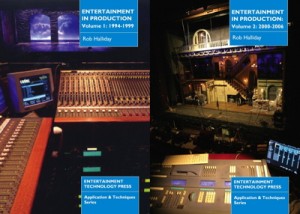 I just heard from my good friend and fellow console connoisseur, Rob Halliday that his books, Entertainment In Production, Volume 1 & 2 have been made available as e-books through Amazon.
I just heard from my good friend and fellow console connoisseur, Rob Halliday that his books, Entertainment In Production, Volume 1 & 2 have been made available as e-books through Amazon.
While I am all about getting the books as e-books, I am still a little miffed that they are only available for the Kindle e-book reader from Amazon. While there is a Kindle App for the iPhone and the iPad, I would love to see the books as native e-books for the iBook app on the iPad. But progress is progress and I can still read/carry them in my iPad.
Here is more information about the e-books from the Press Release:
Writer and lighting programmer & designer Rob Halliday’s books Entertainment In Production vols 1 and 2 are now available to those who prefer their reading in electronic form, through Amazon’s Kindle Store. This means that the books are available not only to readers using Amazon’s Kindle, but also to those using the Kindle software on Apple’s iPad and iPhone, on Blackberries, and on PCs and Macs.
The two Entertainment In Production books gather together more than a decade’s worth of coverage of the creation of some of the world’s most spectacular entertainment projects. The first, covering the period from 1994-1999 includes shows such as Cirque du Soleil’s Mystère and O, the hit musicals Tommy and Mamma Mia, events including the spectacular design for the 71st Academy Awards and the 1996 US Presidential Election Conventions, the reconstruction of London’s Lyceum Theatre and the creation of Las Vegas’ spectacular Fremont Street Experience.
The second book, which covers the period from 2000-2006, includes such shows as the musicals Aida, Chitty Chitty Bang Bang, Fosse, The Woman in White and Mary Poppins, Baz Luhrmann’s Broadway production of La Bohème, Cirque du Soleil’s stunning KÀ, the remarkable Lake of Dreams at the Wynn Hotel in Las Vegas, plus New York’s Tribute in Light.
The articles include insights from many of those involved in these shows, many of which were landmarks in entertainment design and technology; designers whose work features in the books include Acme Sound Partners, Francois Bergeron, Ken Billington, Andrew Bridge, Andrew Bruce, Bob Crowley, Jonathan Deans, Bob Dickinson, Michel Crete, William Dudley, Rick Fisher, Paul Groothuis, Wendall Harrington, Mark Henderson, Howard Harrison, David Hersey, Natasha Katz, Luc Lafortune, Nigel Levings, Matt McKenzie, Anne Militello, Tony Meola, John Napier, Nick Ormerod, Chris Parry, Kenneth Posner, Paul Pyant, Mike Walker, Anthony Ward, Patrick Woodroffe and many more. Rob Halliday was directly involved in the creation of a number of the featured productions, giving a unique insiders view from behind the scenes on these shows.
For more information of the books, visit the dedicated web site at www.entertainmentinproduction.com. You can purchase the e-books from the Amazon.com bookstore for $15.95 each.
FocusTrack Now Includes PowerTrack
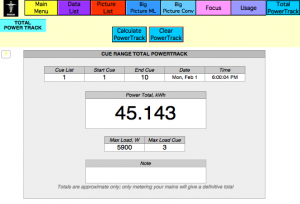 I have mentioned FocusTrack in the past here and here. It seems like the software is getting more and more powerful. Rob Halliday sent me a message about FocusTrack and it’s integration of PowerTrack function for calculating the power usage of a show. Here is more from the Press Release:
I have mentioned FocusTrack in the past here and here. It seems like the software is getting more and more powerful. Rob Halliday sent me a message about FocusTrack and it’s integration of PowerTrack function for calculating the power usage of a show. Here is more from the Press Release:
PowerTrack takes the information about the levels lights are at in cues, which it extracts by importing show file data from ETC Eos/Ion, MA grandMA or Strand 300/500-series consoles, and combines it with information about fixture types and their power consumption that is available from the RigTrack rig management module. This means that it can calculate the approximate load of any given cue – in doing so taking into account not only the level that tungsten lights are at and the constant background load of discharge fixtures, but also the status of more complex fixture such as moving lights that reduce their discharge lamp’s output power when the mechanical dimmer is closed.
In addition to calculating the load cue by cue, FocusTrack can also calculate the overall power usage of a show. To achieve this, it can now learn the timing of a show’s cues during the course of a performance. Based on this timing information – the time in each state and the transition time from state to state, it can calculate the overall consumption of the show.
PowerTrack was added to FocusTrack after requests from a number of theatres who were becoming required to track the power usage of their lighting systems for environmental audit purposes, but whose dimming systems are tied into the overall building power with no separate metering available. The system will also be of use to those taking large scale West End or Broadway productions and working to prepare them for tours, allowing a more precise guide as to the power required than previous ‘guesstimates’ or total connected load calculations.
PowerTrack is now a standard feature of FocusTrack, available in the current version, 2.120, which can be downloaded from the FocusTrack website at www.focustrack.co.uk. FocusTrack is available for Mac or PC; it can be run in demo mode to allow its functionality to be explored. FocusTrack can be found on a wide range of shows around the world, including Billy Elliot worldwide, Come Fly Away, The Addams Family, Mary Poppins and Red in New York, Love Never Dies in London, South Pacific touring the US, and Cirque du Soleil’s Zaia. Further information about FocusTrack and its companion program SpotTrack, for producing followspot cuesheets, can be found at www.focustrack.co.uk.
iSquint Podcast: Episode 7 – Finding Your Next Lighting Desk
 It is that time of year, the trade show season is about to begin. Visitors from around the country and around the world visit trade shows to see some of the latest products and services available to our beloved industry. One of the most talked about and sometimes confusing product to compare is lighting control and consoles.
It is that time of year, the trade show season is about to begin. Visitors from around the country and around the world visit trade shows to see some of the latest products and services available to our beloved industry. One of the most talked about and sometimes confusing product to compare is lighting control and consoles.
So in episode 7, I sat down with Rob Halliday and we talk about lighting control and consoles. Rob Halliday writes reviews about lighting consoles in both Lighting & Sound International and Lighting & Sound America. Rob is a freelance lighting designer and programmer based in England and is known to show up state side now and then.
Our goal of this conversation was to get you to think about what you are specifically looking for out of your next lighting console or, if you really even need a new console!
Rob and I talked at length about different types, function and abilities of lighting desk to help you understand some of the choices you have out there. While we did mention a couple of brands and specific consoles in the podcast, we are not endorsing or recommending those desk. We used them as examples to help illustrate our points as the desk are well known throughout the industry.
If you have additional questions or comments, Rob and I will be happy to help. You can reach either of us through the Contact Us page here on iSquint.net.
Did you know: You can subscribe to the iSquint Podcast through iTunes for free?
[podcast]http://isquint.net/wp-content/uploads/podcast/iSquint.net_Podcast-Episode_7.mp3[/podcast]
Love Never Dies – A Glimps Into the Design Process

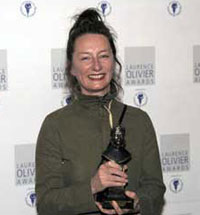 Rob Halliday, a new friend and fellow Lighting Design and writer let me in on a little known web site yesterday. The site is a journal of Mrs. Paule Constable, a leading lighting designer out of the UK. You may remember Mrs. Constable winning the 2009 Laurence Olivier Award for Best Lighting Design for her design of The Chalk Garden.
Rob Halliday, a new friend and fellow Lighting Design and writer let me in on a little known web site yesterday. The site is a journal of Mrs. Paule Constable, a leading lighting designer out of the UK. You may remember Mrs. Constable winning the 2009 Laurence Olivier Award for Best Lighting Design for her design of The Chalk Garden.
Mrs. Constable’s next project is Andrew Lloyd Webber’s sequel to The Phantom of the Opera, Love Never Dies at the Adelphi Theatre in London. Mrs. Constable started a blog on her website, pauleconstable.com detailing her experiences while designing the show. This is a rare look into the design process of a large Broadway type show that we almost never hear about.
I encourage you to take a look and follow Mrs. Constable’s design process with the show. Mrs. Constable just started writing about her experiences this month, but as the process continues, I am certain she’ll keep us up-to-date.
You can learn more about Andrew Lloyd Webbers latest show, Love Never Dies by visiting the show’s web site at www.loveneverdies.com. Previews for the show start February 20th and Opening night sometime early March.
Thanks Rob!
FocusTrack 2.100, Available Now with QuickFocus
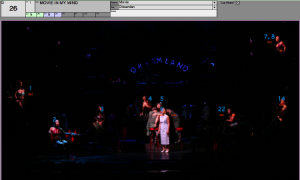 FocusTrack, the software that tracks the position and movement of your lights through your show has just recently been updated to include QuickFocus within the software. FocusTrack adds QuickFocus, for quick manual documentation of focuses and creation of cue-by-cue focus summaries.
FocusTrack, the software that tracks the position and movement of your lights through your show has just recently been updated to include QuickFocus within the software. FocusTrack adds QuickFocus, for quick manual documentation of focuses and creation of cue-by-cue focus summaries.
More from the Press Release:
Continuing to respond to the needs of lighting professionals, the new version adds QuickFocus, a new, dual-purpose and invaluable function for documenting and then viewing the use of each moving light in each cue.
“FocusTrack was conceived as a way of creating precise documentation of show lighting, making use of the information available from the lighting console once the lighting was nearing completion,” explains FocusTrack’s Rob Halliday. “When used like that it works fantastically well. But we know that a lot of people still prefer to track what their moving lights are doing as they are making the show, with either the designer or programmer jotting down notes of their own, or on larger shows with this task being undertaken by a moving light tracker. They could use FocusTrack, but it was a bit awkward. QuickFocus was conceived as a way of making their work easier.”
QuickFocus presents a grid for each cue in the show; into that grid can be placed an image for that cue, so a storyboard, set drawing or, once things are a little more advanced, a photograph of the lighting state. Channel numbers can then be placed on that grid in the spot where that light’s beam lands; the focus palette the light is using can also be recorded, and a focus note can be added. This gives a very clear overview of what the lights are doing in each cue, and one that is easy to fill in as the cue is made.
If the show is subsequently imported from the console showfile, FocusTrack can reconcile the focuses in the QuickFocus grid with those imported from the console to provide. Alternatively, those using FocusTrack in its original manner can use the grid to define where each light falls in each focus; FocusTrack can then build a QuickFocus grid for each cue.
In every case, it is now possible to quickly and easily produce paperwork summarising what each moving light is doing in each cue – a great reference for designers, associates, programmers and those running the show from day to day. In addition to QuickFocus, FocusTrack 2.100 continues the software’s ongoing evolution, with screen displays re-designed for greater clarity and other refinements and improvements.
For more information, download a demo show or to purchase a copy of FocusTrack, visit their website at www.focustrack.co.uk.
New Software: SpotTrack Followspot Cue Software
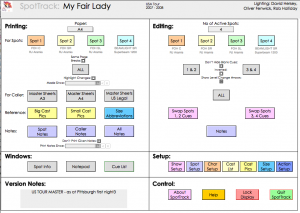 Rob Halliday, the creator of the FocusTrack software has announced the release of a new tracking software package called SpotTrack.
Rob Halliday, the creator of the FocusTrack software has announced the release of a new tracking software package called SpotTrack.
SpotTrack is a new program for making and managing followspot cue sheets – something that has traditionally been done in Excel or Word using ad-hoc documents created from scratch as required. SpotTrack, by contrast, has been built for the job – managing shows with one to four spots, and making it easy to do things that have traditionally been hard, like printing the cue sheets for each spot without it being full of blank lines occupied by cues for the other spots. At the same time, SpotTrack breaks up the cue sheet into scenes or songs, making it easy for the caller and all of the spot ops to find their place when jumping around the show during technical rehearsals.
SpotTrack also aims to reduce the amount of typing required of whoever is running the spots – the LD, associate or spot caller. Clustered around the main cue sheet area are shortcut buttons that can be customized with character names, beam sizes or regularly-used instructions – ‘iris in’, ‘fade out’ or whatever. All of those things are then just a click away.
SpotTrack provides a home for lots more information than just the spot cues themselves: it can store the setup for each spot (type, colour load, operator), details of the characters in the show (name, cast name, understudy name), pictures of the characters, and even the show’s cue list, which can be imported from FocusTrack which can, in turn, import show data from ETC Eos/Ion, MA grandMA and Strand 500-series consoles.
SpotTrack is available on a “per Show” license through SpotTrack.co.uk at £45 UK or $72. USD. What makes purchasing a copy of SpotTrack unique is that a portion of the purchase price goes to either ESTA’s Behind the Scenes or the UK’s Light Relief to help our brothers and sisters who are unable to work. For more information, download a demo or to purchase a copy of SpotTrack, visit their website at www.SpotTrack.co.uk.
LatestHeadlines
- Upgrading Your Toolbox: City Theatrical DMXcat-E and DMXcat Multi Function Test Tool
- Claypaky Bringing Back the Sexy to Par Cans with the Midi-B FX
- Ayrton Evolves the Cobra, the Cobra2 Developed for the US Market
- MA Lighting Intros grandMA3 onPC Fader Wing and DIN-Rail Nodes
- Live Events LEVL Up Fest: A Festival to Aid our Industry